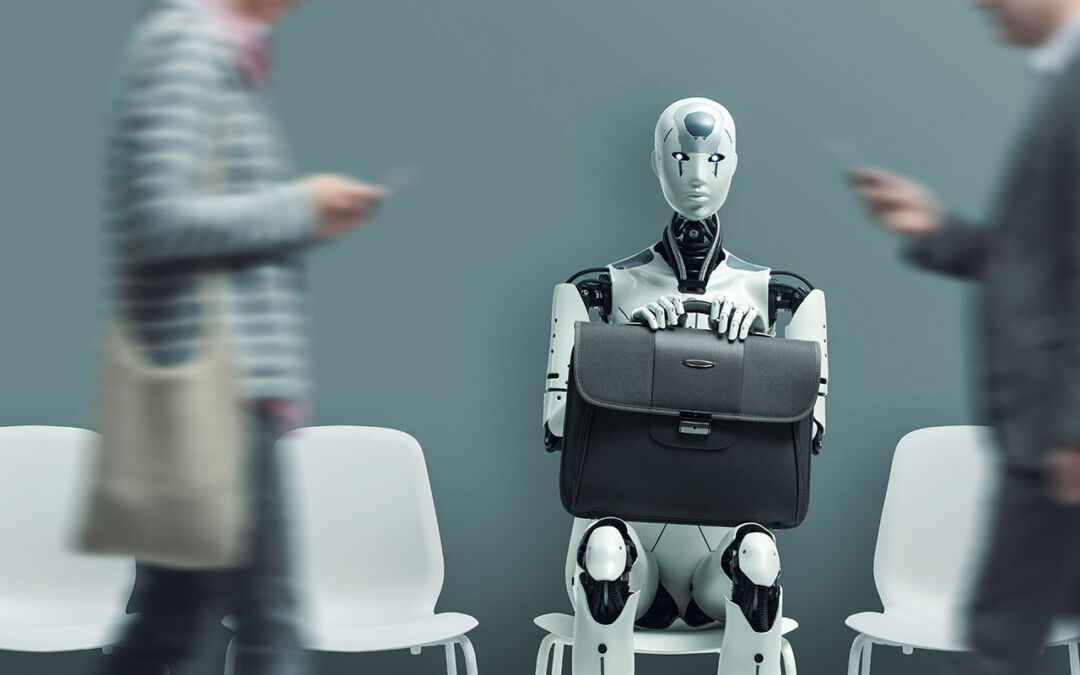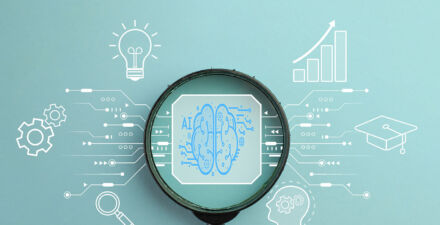Boosting U.S. worker power and voice in the AI-enabled workplace


Key takeaways
The deployment of Artificial Intelligence in the workplace has grown rapidly in the United States. Labor unions have been at the forefront of efforts to encourage more productive and sustainable workplace AI and digitalization strategies. Case studies from Germany and the United States show the importance of public policy for supporting worker voice in new technology adoption and deployment.
Policy options that could be considered at the state and local levels in the United States to boost worker power and voice in the era of AI innovation include:
- Legislation regulating employer AI usage: laws that prohibit excessive surveillance, data collection, and automated decision-making by employers; that regulate employers’ use of electronic monitoring and automated decision systems; and that require employers to conduct impact assessments of AI usage
- Legislation implementing human oversight of AI tools: laws that put guardrails on replacing humans with digital technologies by requiring human oversight in sensitive sectors
- Protections for workers exposed to AI: requiring retraining and severance for displaced workers, state and local procurement of AI tools that focus on their equity and impacts on workers, and agency actions to take on deceptive and unfair practices by employers
Overview
Employers are rapidly deploying digital tools that apply algorithms and artificial intelligence1 to restructure operations and manage workers.
Economists have observed that this corporate deployment of AI embeds existing power relations in the workplace and is biased toward automation applications focused on short-term cost savings. These trends risk increasing unemployment and inequality, as well as stagnating productivity in the United States.2
Studies also have identified risks to workers, customers, and citizens from the widespread application of algorithmic tools to automate surveillance and management decision-making, based on often biased and faulty models.3
But AI does not have to be deployed as such and indeed can have positive impacts on workers and the workplace. Research shows that the quality of AI models improves when the people who use them participate in developing these models, selecting and maintaining data, and interpreting and verifying results.4 Management research likewise finds that workplaces with high trust, worker autonomy, and investment in workers’ skills experience better performance outcomes and innovations associated with AI investments.5
Public policy can help support this alternative approach to AI adoption and deployment that benefits firms, workers, customers, and our broader society. Legislated minimum standards and collective bargaining institutions that support worker voice are needed to rebalance power in the workplace and to place productive constraints on employers that encourage investments in expanded worker discretion and skills.6 These institutions have long supported quality-focused competitive strategies during technology-related restructurings,7 and they are just as crucial today.8
In this policy brief, we argue that policies strengthening worker rights and power are crucial to encouraging a high-road approach to AI that complements rather than replaces workforce skills. A case study of Deutsche Telekom AG in Germany shows the potential of collective bargaining to support this high-road approach in a context where strong worker rights support more balanced workplace power. We then turn to the United States to examine how unions are responding to similar challenges. We conclude with recommendations that follow from our analysis.
Let’s turn first to Germany.
Worker voice and mutual gains in Germany: The case of Deutsche Telekom
Institutional support for worker voice
Germany has among the strongest worker rights in the areas of data protection and participation in management decision-making.9 Two areas in particular stand out: protections against unauthorized worker data collection and strong collective bargaining rights.
German law has long prohibited the unauthorized collection, processing, and storage of workers’ personal data. Indeed, Germany has had a federal data protection act since 1978, which has been updated over the years, including to conform with EU data protection regulations.10
Worker representatives in Germany also have very strong legal bargaining rights. In Germany, labor unions typically negotiate collective agreements at the company or sector level, including over areas such as worker pay, working time, and job security. Meanwhile, works councils made up of elected employees within companies negotiate separate “works agreements” at the company and workplace levels over a range of management practices, including scheduling, variable pay, health and safety, and performance monitoring.
Strong co-determination rights, which give employees a voice in how their company is run, give works councils different possibilities to negotiate binding rules relevant to the usage of AI and algorithms. Many works agreements, for example, ban the collection of individual performance data, which can limit the use of speech analytics tools or workforce management software.
In addition, a revision to Germany’s Works Constitution Act in 2021 extended works councils’ consultation rights on new technologies to include AI-based tools. It also extended co-determination rights over selection guidelines for hiring, transfers, and terminations to include situations in which AI is used, and it requires companies to fund an expert (engaged by the works council) to consult on proposed changes or policies involving AI.
Worker voice at Deutsche Telekom
The case of Deutsche Telekom AG shows how this different institutional framework of rights supports strong worker voice in AI-based technology adoption and deployment.11 Deutsche Telekom’s works councils negotiate works agreements, and the labor union Vereinte Dienstleistungsgewerkschaft, or Ver.di, negotiates separate but coordinated collective agreements.
Works agreements restrict supervisors’ access to individual performance data and require that this information is used to develop, rather than to discipline, workers.12 In addition, an agreement from 2010 states that automation should first be used to reduce subcontracting. This provision gave workers a baseline of job security to encourage joint labor-management efforts to improve efficiency.
In the mid-2010s, Deutsche Telekom’s works council organized an 8-month project to analyze the workforce impact of new digital, algorithm, and AI-enabled tools. Based on that project’s findings, a series of works agreements established the following rules and processes:
- Management must consult with the works council before purchasing new technology. After evaluating the risk to workers, the two parties decide jointly whether to prohibit or negotiate over the tool.
- Management draws up a “digi-road map” laying out planned digitalization measures. Management then meets with the works council to discuss, and eventually negotiate over, the impacts on employment, service quality, and work content.
- A labor-management Workforce Analytics Expert Group reviews how employee data and AI-enabled analytics tools are used. It holds regular evaluation workshops and provides training for employees to use workforce analytics responsibly.13
- A labor-management AI Ethics Committee reviews AI-based tools and systems compliance with agreed-upon ethics provisions.14
Additionally, in 2024, aWorking Time Agreementwas negotiated to deploy an intelligent predictive shift-planning tool. With this tool, workers are able to choose their own shifts, and the AI-enabled system then creates an optimal “duty roster.”
Impacts on job quality and service quality
Together, these collective agreements placed productive constraints on management, supporting a high-road approach to AI adoption at Deutsche Telekom in two main ways: using AI tools that enhance skills rather than discipline workers and giving workers a choice in how they use AI tools.
First, job security and limits on individual monitoring encouraged management to invest in AI tools that enhanced skills and service quality rather than increasing worker discipline and control. Workers are protected from invasive monitoring and privacy abuses, and workforce analytics and coaching tools are only used where they comply with clear rules; the fairness and use of these tools is evaluated by joint worker-management committees.
This process reduced the risk to management that works councils would oppose expensive IT systems after they had already been purchased. It also improved worker trust in how managers were using controversial tools, such as speech analytics software, which uses AI and natural language processing to analyze recorded customer conversations and identify recurring issues to more quickly address network or service problems.
Second, these agreements gave workers more choice and control over how they use AI-based tools, encouraging creative applications that improve productivity, scheduling flexibility, and service quality. Call-center workers, for example, could choose whether and how to use Deutsche Telekom’s agent-assistant tool to look up information relevant to customer calls. A majority did choose to use it and also were involved in correcting its mistakes to improve the information it provided. Similarly, the intelligent predictive shift-planning tool mentioned above was broadly welcomed by workers, who were able to more closely tailor their schedules to balance work with their families and lives outside of work—all while meeting management’s goals of more flexible staffing.
Managers reported that the benefits of this deliberative approach to AI adoption could be most clearly seen in the company’s increasing service quality scores and so-called first-call resolution (meaning fewer customers had to call back due to unresolved problems). Meanwhile, worker representatives secured in-house jobs at good pay, with employment security and worker control over how they did their jobs, drawing on their experience and skills. This allowed employees to focus on providing good-quality customer and technician service.
The high rates of customer satisfaction and first-call resolution also added significant value to job quality, as stress and burnout in service jobs very often result from frequent interactions with dissatisfied or abusive customers.15
How workers are using collective voice in the United States
The United States has weaker data protection and labor laws than Germany. While a growing number of U.S. states have passed data privacy laws, most of these are targeted to consumer data, and some even explicitly exclude workers from protections.16
Yet there also are many examples where unions are using or building institutions that support worker voice to address similar challenges as those seen in Germany, including to prohibit certain uses of AI, to improve job security and reduce workplace monitoring, and to strengthen worker voice in AI decision-making.
Prohibiting certain uses of AI
The Deutsche Telekom example shows the benefits of clear, bright-line rules prohibiting certain uses of AI.
In the United States, recent hard-fought collective agreements negotiated by the Writers Guild of America,17 or WGA, as well as actors at SAG-AFTRA,18 similarly place strict limits on how generative AI is used in these creative jobs. The WGA, for example, won provisions in its 2023 contract restricting the use of AI-generated scripts, requiring disclosure of AI-generated material, and giving writers control over whether and how they use AI software. SAG-AFTRA’s agreement, meanwhile, restricts the use of digital replicas of actors, requiring consent for creating and using digital replicas and regulating compensation for the use of these replicas.
Likewise, members of The NewsGuild-Communications Workers of America, or CWA, have negotiated contracts that prevent any use of generative AI except by working journalists themselves, prohibit job cuts driven by AI, and make clear that only journalists do the work of journalism.19
Improving job security and reducing work intensification and monitoring from AI-based tools
Similar to the unions and works councils at Deutsche Telekom, the CWA has long responded to threats from automation at U.S. telecom employers, such as AT&T Inc. and Verizon Communications Inc., with agreements improving job security and retraining.20 Agreements also provide protections against disciplining employees if they do not meet certain time-based measures and specify that monitoring technologies should be used primarily for training purposes.21
Past research finds that these kinds of negotiated supports for worker skills and voice create benefits for sales, service quality, and employee retention.22 These agreements continue to protect workers from unfair discipline as new AI monitoring technology evaluates tone of voice and adherence to scripts, and new automation tools speed up work.23
Other unions have organized similar efforts in other service industries to adapt past agreements to new threats from AI- and algorithm-based tools. Unionized workers’ 2023 contract with United Parcel Service Inc. includes language prohibiting the implementation of new technologies that would eliminate significant parts of the workforce until 2028, including drones, driverless vehicles, platooning of semi-trucks, and other AI.24
Similarly, UNITE HERE Local 226 in Las Vegas negotiated new contracts in 2023 for 40,000 hotel and casino workers that strengthened existing technology protections, including advance notice, training, severance pay, privacy rights, and expanded bargaining rights.25 In one case, housekeepers won back control over the sequence of rooms they clean through analyzing data records from the software applications that workers were required to use for cleaning rooms and filling orders.26
Strengthening worker voice in AI decisions
At Deutsche Telekom, the works councils strengthened their own capacity through studying AI’s uses and employment impacts and then establishing clear principles and joint committees to steer those uses and impacts. Similar initiatives can be seen in the United States.
U.S. National Nurses United, or NNU, found that the use of generative AI for shift scheduling and remote patient monitoring was widely perceived by their members as harming patient care by undercutting nurses’ skills and nuanced understanding of patients’ needs.27 The union then developed an AI bill of rights for nurses and patients, drawing on these findings and experiences.28 These principles, in turn, have been deployed by NNU members in many hospitals through established technology committees.
The CWA also has organized Technology Change committees since the 1950s, and organizational support for these committees is included in many of its telecom collective agreements.29 A priority of worker representatives on these committees is to focus on technology applications that improve the quality of service, taking into account a broader range of stakeholders.
The CWA also has studied the use and worker impacts of AI.30 The union then used this research both to educate local representatives and to support collective bargaining. The union published a set of AI principles in 2023 based on the deliberations of a committee of members from the telecom, media, and technology sectors.31
Similar initiatives can be seen across other unions, including:
- The WGA West’s Board, covering film, TV, radio, and new media writers, has appointed an AI advisory committee that is documenting writers’ experiences with and developments in AI.
- IATSE, a union for theatrical stage workers, published a set of AI principles in July 2023 that includes a demand for “transparency from employers regarding their use of AI.”32 In 2024, IATSE members ratified a new contract that establishes ground rules for the use of AI, a committee to facilitate AI skills training, and requirements that AI use cannot be outsourced to nonunion labor, among other provisions.33
- The United Auto Workers-Ford’s Letters of Understanding, which outline terms not covered in their union contract, include provisions under which a joint committee “will research AI technology for worker safety and how it applies to facility operations.” The Letters of Understanding also establish that management will provide advance notice on new technology, with investment in training programs.34
These examples show that U.S. workers and their unions have been creative in adapting existing agreements and developing new joint initiatives. Yet they also are limited in their ability to extend and deepen worker voice due to lower bargaining coverage,35 weaker bargaining rights, and an overall weaker framework of baseline data protection rules. Agreements protecting workers (and customers) from the worst abuses of algorithmic management and de-skilling cover only a minority of U.S. workers, even in the sectors where these agreements are present.
Policy recommendations
How can the lessons learned from these case studies from Germany and the United States be extended more broadly across the U.S. workforce? Most importantly, to support worker voice in AI decisions, we need policies and strategies that strengthen worker power. The German experience suggests that a longer-term goal should be labor law reforms that remove the steep obstacles to organizing unions in U.S. workplaces and strengthens collective bargaining rights.36 U.S. firms with union-represented employees can also pursue a high-road path by bargaining constructively over digital technology implementation.
Despite weak institutional supports, many U.S. unions have won contract provisions related to technology and, through decades of case law, established the right to negotiate over technology changes that impact working conditions and freedom of association.37 U.S. firms that aim to use digital technology to complement their workforces should look to the German model of co-determination, which harnesses the collective wisdom of front-line workers alongside management to guide changes to work processes that maximize both productivity and job quality.
Worker power also can be buttressed against the most harmful and invasive uses of digital technologies with baseline legal protections at local, state, and federal levels.38 The EU’s recent AI Act is a potential model in its explicit prohibition on using AI to measure or emulate human emotions in workplaces and educational settings—a red line that would rein in abuses in call centers and other service-sector jobs.39 To protect workers from exploitative use of digital metrics and monitoring, policymakers can prohibit excessive surveillance, data collection, and automated decision-making.
Some examples include:
- State bills, such as California’s 2022 Workplace Technology Accountability Act,40 as well as New York State’s 2024 Bossware and Oppressive Technologies Act,41 lay out a broad framework for regulating employers’ use of electronic monitoring and automated decision systems, and also require employers to conduct impact assessments.42
- Warehouse workers have called for limits on algorithmic metrics, such as Amazon’s “time off task,” that undermine worker health and safety, with legislation passed in California and proposed in several other states.43
- So-called just cause bills in Illinois and New York City limit the use of electronic monitoring data in dismissing workers.
- Bills that address sector-specific risks by requiring worker oversight on AI decisions can provide baseline protections requiring a human-in-command approach, for example, in healthcare and publishing.44
To protect against employers rushing to cut costs by substituting AI tools for human workers, unions also are pursuing contractual protections for job security. Many unions are exploring legislative strategies, too, including requiring notice, retraining, and severance for workers who experience technology-driven job loss, as proposed in New Jersey,45 and prohibiting replacement of workers with digital technology in specific industries that would harm the public, such as in community colleges,46 call centers,47 and healthcare.48
At the federal level, the Biden administration asserted that agencies have some existing authority to take on deceptive and unfair employer practices around AI tools,49 and President Biden’s Office of Management and Budget encouraged agencies to consult employee unions on the design, development, and use of AI—actions that have since been rescinded by the Trump administration.50
Government also has significant influence on technology development through its procurement of goods and services. In March 2024, the White House Office of Management and Budget issued a memo on AI governance that encouraged agencies to consult with federal employee unions, among other impacted groups, on the design, development, and use of AI.51 Though the Trump administration has since rescinded this guidance as well,52 states and localities have begun to adopt their own guidance on procurement of AI tools that foregrounds equity and impacts on workers.53
Conclusion
Workers and their unions have been at the forefront of efforts to regulate the use of AI and other digital technologies in a variety of U.S. workplaces. Yet collective agreements cover only a minority of workers. Most employers lack much-needed productive constraints on low-road strategies relying on automation, de-skilling, and intensified surveillance.
Frontline workers are well-positioned to steer AI investments toward the high-road alternative, but only if the broader public and policymakers have their backs. Policies that strengthen worker rights and worker power are critical for securing broadly shared prosperity in the era of AI innovation.
In Conversation with Daron Acemoglu
May 8, 2023
About the authors
Virginia Doellgast is the Anne Evans Estabrook Professor of Employment Relations and Dispute Resolution in the ILR School at Cornell University. Her research focuses on the comparative political economy of labor markets and labor unions, inequality, precarity, and democracy at work. She is currently studying the impact of digitalization and AI on job quality in the information and communication technology services industry, based on comparative research in North America and Europe. She is author of Exit, Voice, and Solidarity (Oxford University Press, 2022) and Disintegrating Democracy at Work (Cornell University Press, 2012); and co-editor of International and Comparative Employment Relations (Sage, 2021) and Reconstructing Solidarity (Oxford University Press, 2018).
Nell Geiser is director of research for the Communications Workers of America, a labor union representing workers in telecommunications, media, technology, public service, airlines, manufacturing, and other sectors. Geiser and the research department support CWA initiatives across collective bargaining, policy, and organizing. She has worked as a researcher for labor unions since 2006. Geiser has a B.A. from Columbia University and in 2014, she fulfilled the requirements to become a Chartered Financial Analyst.
Did you find this content informative and engaging?
Get updates and stay in tune with U.S. economic inequality and growth!
End Notes
1. Artificial intelligence refers to computer systems that can perform tasks traditionally requiring human intelligence, including advanced pattern recognition and problem-solving. Increasingly, technologies integrate robotic process automation, which is used to automate repetitive, rule-based tasks (based on structured data inputs and logic) with machine learning, which can identify patterns in unstructured data and improve its accuracy over time through, for example, neural or deep learning networks. Generative AI tools, such as ChatGPT, are a class of machine learning technologies that generate new content based on this analysis of patterns in data.
2. Daron Acemoglu and Pascual Restrepo, “The Wrong Kind of AI.” Working Paper 25682 (NBER, 2019), available at https://www.nber.org/papers/w25682; U.S. Department of the Treasury, “The State of Labor Market Competition” (2022), p. i, available at https://home.treasury.gov/system/files/136/State-of-Labor-Market-Competition-2022.pdf; Josh Bivens and Ben Zipperer, “Unbalanced labor market power is what makes technology—including AI—threatening to workers” (Washington: Economic Policy Institute, 2024), available at https://www.epi.org/publication/ai-unbalanced-labor-markets/.
3. Ifeoma Ajunwa, “The ‘black box’ at work,” Big Data & Society 7 (2) (2020); Sara Baiocco and others, “The Algorithmic Management of work and its implications in different contexts.” Working Paper No. 2022/02 (JRC Working Papers Series on Labour, Education and Technology, 2022); Clara Berridge and Alisa Grigorovich, “Algorithmic harms and digital ageism in the use of surveillance technologies in nursing homes,” Frontiers in Sociology 7 (2022); Joy Buolamwini, Unmasking AI: My mission to protect what is human in a world of machines (New York: Penguin Random House, 2024); Yotam Margalit and Shir Raviv, “When Your Boss is an Algorithm: The Effect of Algorithmic Management on Worker Performance” (2024), available at https://ssrn.com/abstract=4776355; Agnieszka Piasna, “Algorithms of time: How algorithmic management changes the temporalities of work and prospects for working time reduction,” Cambridge Journal of Economics 48 (1) (2024): 115–132.
4. Martin Krzywdzinski, Detlef Gerst, and Florian Butollo, “Promoting human-centred AI in the workplace. Trade unions and their strategies for regulating the use of AI in Germany,” Transfer: European Review of Labour and Research 29 (1) (2023): 53–70.
5. Sarah Bankins and others, “A multilevel review of artificial intelligence in organizations: Implications for organizational behavior research and practice,” Journal of Organizational Behavior 45 (2) (2024): 159–182. Our own analysis of results from a U.S. call center survey finds that workers using AI-based tools reported better outcomes for themselves, their customers, and their performance where they also felt that management practices were more developmental and fair—that is, where they agreed that monitoring information was used for skill development rather than for punishing or sanctioning workers—that metrics were reasonable, and that workers’ rights to personal privacy were protected. Virginia Doellgast, Jeonghum Kim, and Sean O’Brady, “Call center workers’ experiences with AI-based coaching tools: the role of experience, task complexity, and management practices” (forthcoming.)
6. The term productive constraints was used by Streeck to describe the role of German institutions, including industrial relations, vocational training, and employment protection legislation, in encouraging an alternative “diversified quality production” approach to gaining competitive advantage in manufacturing sectors in the 1980s and 1990s. Wolfgang Streeck, “Productive constraints: on the institutional conditions of diversified quality production.” In Streeck, ed., Social institutions and economic performance: Studies of industrial relations in advanced capitalist economies (Thousand Oaks, CA: Sage Publications, 1992), pp. 1–40.
7. Rosemary Batt, R., Alexander J.S. Colvin, and Jeffrey H. Keefe, “Employee Voice, Human Resource Practices, and Quit Rates: Evidence from the Telecommunications Industry,” Industrial and Labor Relations Review 55 (4) (2002): 573–593; Christian Berggren, Alternatives to lean production: Work organization in the Swedish auto industry (Ithaca, NY: Cornell University Press, 1993); Ronald P. Dore, Stock market capitalism: Welfare capitalism: Japan and Germany versus the Anglo-Saxons (Oxford, UK: Oxford University Press, 2000); Richard B. Freeman and Kathryn L. Shaw, eds., International differences in the business practices and productivity of firms (Chicago: University of Chicago Press, 2009); Jody Hoffer Gittell, Andrew Von Nordenflycht, and Thomas A. Kochan, “Mutual gains or zero sum? Labor relations and firm performance in the airline industry,” Industrial and Labor Relations Review 57 (2) (2004): 163–180; Peter A. Hall and David Soskice, eds., Varieties of Capitalism: The Institutional Foundations of Comparative Advantage (Oxford, UK: Oxford University Press, 2001); Thomas A. Kochan, and Paul Osterman, The Mutual Gains Enterprise (Cambridge, MA: Harvard Business School Press, 1994); Saul A. Rubinstein, “The Impact of Co-Management on Quality Performance: The Case of the Saturn Corporation,” Industrial and Labor Relations Review 53 (2) (2000):197–218.
8. See also: Philippa Collins and Joe Atkinson, “Worker voice and algorithmic management in post-Brexit Britain,” Transfer: European Review of Labour and Research 29 (1) (2023): 37–52; Mathieu Dupuis, “Algorithmic management and control at work in a manufacturing sector: Workplace regime, union power and shopfloor conflict over digitalisation,” New Technology, Work and Employment, May 23, 2024, available at https://onlinelibrary.wiley.com/doi/10.1111/ntwe.12298.
9. Research in Germany has shown that these institutional supports for worker voice can encourage employers to adopt AI in a way that invests in skills to complement new tools, while limiting invasive monitoring. See Krzywdzinski, Gerst, and Butollo, “Promoting human-centred AI in the workplace. Trade unions and their strategies for regulating the use of AI in Germany”; Didem Özkiziltan, “Governing Engels’ pause: AI and the world of work in Germany,” ILR Review 77 (5) (2024): 846–856. At the same time, studies have found significant variation at the workplace and firm levels due to variations in works council and union power and in employer resistance. A 2023 German survey of 385 managers and 224 works councilors found half of surveyed companies reporting cooperative relationships on AI and that more cooperative co-determination was associated with greater employee involvement on AI adoption and higher acceptance of AI technologies among the workforce. See Martin Krzywdzinski, “Zwei Welten der KI in der Arbeitswelt Wie Management und Betriebsräte die Einführung und Nutzung von KI-Anwendungen gestalten.“ Discussion Paper #39 (Weizenbaum, 2024), available at https://www.weizenbaum-library.de/server/api/core/bitstreams/dd69f1ed-98ce-4b64-a996-d44521919ba3/content; Anke Hassel and Didem Özkiziltan, “Governing the work-related risks of AI: implications for the German government and trade unions,” Transfer: European Review of Labour and Research 29 (1) (2023): 71–86; Martin Krzywdzinski, Daniel Schneiß, and Andrea Sperling, “Between control and participation: The politics of algorithmic management,” New Technology, Work and Employment, April 13, 2024, available at https://onlinelibrary.wiley.com/doi/10.1111/ntwe.12293.
10. The current Federal Data Protection Act was revised to conform with the EU’s General Data Protection Regulation.
11. Virginia Doellgast, Exit, voice, and solidarity: Contesting precarity in the U.S. and European telecommunications industries (Oxford, UK: Oxford University Press, 2022). For more detail on the Deutsche Telekom case, see: Virginia Doellgast, Ines Wagner, and Sean O’Brady, “Negotiating limits on algorithmic management in digitalised services: cases from Germany and Norway,” Transfer: European Review of Labour and Research 29 (1) (2023): 105–120; Virginia Doellgast and Tobias Kämpf, “Co-determination meets the digital economy: works councils in the German ICT services industry,” Entreprises et histoire (4) (113) (2023): 32–43; Thomas Haipeter and others, “Human-centered AI through employee participation,” Frontiers in Artificial Intelligence 7 (2024).
12. Individual performance data can be gathered only for groups of at least five workers. Workers can see their own performance data but choose whether to share this with team leaders, who are prohibited from requesting it.
13. In addition, a works agreement establishes that workforce analytics tools should be used to improve the working environment and to support management decisions. Analytics cannot be used to monitor individual performance or to make automated decisions without human oversight.
14. These provisions include: Interactions with “learning machines” must be designed so that workers know that they are interacting with AI, and human decision-makers (not AI) must make significant personnel-related decisions. Certain uses of AI are prohibited, including gathering personal information about employees’ political opinions, philosophical beliefs, union membership, or sexual orientation, or seeking to analyze or influence employees’ emotions or mental state. Technologies that ascribe personality traits or use biosensors are not allowed.
15. Sean O’Brady, Virginia Doellgast, and David Blatter, “The high costs of outsourcing: Vendor errors, customer mistreatment, and well‐being in call centers,” Industrial Relations: A Journal of Economy and Society 63 (1) (2024): 80–103; Xiangmin Liu, Danielle D. van Jaarsveld, and Yoshio Yanadori, “Customer aggression, employee voice and quit rates: Evidence from the frontline service workforce,” British Journal of Industrial Relations 60 (2) (2022): 348–370.
16. Annette Bernhardt, Lisa Kresge, and Reem Suleiman, “The data-driven workplace and the case for worker technology rights,” ILR Review 76 (1) (2023): 3–29. California’s Privacy Rights Act is an exception in that it does give workers some limited rights to information on data collected by their employer. Kung Feng (2023) writes: “Under the CCPA, workers have the right to know when employers are monitoring them and for what purpose. They can access their data and request to correct or delete it. They can know if employers are profiling them or buying data about them, like social media activity. And they can opt out of employers selling their data.” See Kung Feng, “Overview of New Rights for Workers Under the California Consumer Privacy Act” (Berkeley, CA: UC Berkeley Labor Center, 2023), available at https://laborcenter.berkeley.edu/overview-of-new-rights-for-workers-under-the-california-consumer-privacy-act/.
17. Writers Guild of America, “Know Your Rights: Artificial Intelligence” (2024), available at https://www.wga.org/contracts/know-your-rights/artificial-intelligence#:~:text=WGAW%20endorsed%20the%20Generative%20AI,training%20datasets%20for%20AI%20models.
18. SAG-AFTRA, “Regulating Artificial Intelligence” (2023), available at https://www.sagaftra.org/sites/default/files/sa_documents/AI%20TVTH.pdf.
19. See, for example, “Memorandum of Agreement between the News Media Guild and the Associated Press,” (2023), p.15, available at https://newsmediaguild.org/wp-content/uploads/2024/05/Contract-2024-Editorial-Unit.pdf; Rebekah Entralgo, “Prime Day Walkout Averted at Ziff Davis,” New York NewsGuild, July 15, 2024, available at https://newsguild.org/prime-day-walkout-averted-at-ziff-davis/; Independent Association of Publishers’ Employees TNG-CWA Local 1096, “Contract 2024 – Now You Decide,” June 20, 2024, available at https://www.iape1096.org/iapework/2024/6/20/contract-2024-now-you-decide; NewsGuild, “Omaha World-Herald journalists secure new contract,” May 31, 2024, available athttps://thenewsguild.wpenginepowered.com/omaha-world-herald-journalists-secure-new-contract/. This follows embarrassing instances of high-profile news organizations, such as Gannett and Sports Illustrated, using AI to produce news more cheaply but with a loss of journalistic oversight and accuracy. See David Bauder, “Sports Illustrated found publishing AI generated stories, photos and authors,” PBS Newshour, November 29, 2023, available at https://www.pbs.org/newshour/economy/sports-illustrated-found-publishing-ai-generated-stories-photos-and-authors; Clare Duffy, “Gannett to pause AI experiment after botched high school sports articles,” CNN, August 31, 2023, available at https://www.cnn.com/2023/08/30/tech/gannett-ai-experiment-paused/index.html.
20. These include provisions prohibiting layoffs for the term of the agreement, requiring management to offer workers a job they are qualified for at another location when there are layoffs, and limiting the share of work that can be sent to contractors.
21. CWA, “CWA Contract Provisions to Promote Good Working Conditions for Customer Service Workers” (2014), available at https://cwa-union.org/sites/default/files/6-cwa-issue-briefs.pdf. For background on call center workers’ experience of AI, see CWA, “How Artificial Intelligence is Impacting CWA Customer Service Professionals” (2024), available at https://cwa-union.org/sites/default/files/2023-11/call_centers_and_new_technology_fact_sheet.pdf, drawing from Virginia Doellgast and others, “AI in Contact Centers” (Ithaca, NY: ILR School, 2023), available at https://ecommons.cornell.edu/server/api/core/bitstreams/a0ac9f50-5a22-4b3d-a9d9-2cc06824e31d/content.
22. Rosemary Batt, “Managing customer services: Human resource practices, quit rates, and sales growth,” Academy of Management Journal 45 (3) (2002): 587–597; Virginia Doellgast, Ursula Holtgrewe, and Stephen Deery, “The effects of national institutions and collective bargaining arrangements on job quality in front-line service workplaces,” ILR Review 62 (4) (2009): 489–509.
23. Contract language protecting time for paid breaks and “closed key time” to follow up after calls also provides a tool to moderate the growing intensity of time on calls or screens, as AI-based tools reduce the need for follow-up work.
24. Lisa Kresge, “Negotiating Workers’ Rights at the Frontier of Digital Workplace Technologies in 2023” (Berkeley, CA: UC Berkely Labor Center, 2023).
25. These include provisions to guarantee advanced notification when new technology is introduced that would impact jobs, require access for existing workers to training for new jobs created by technology, health care and severance pay for workers who are laid off because of new technology, the right to privacy from tracking technology introduced by companies, notice of third-party data-sharing workers have generated through their work, and the right to bargain over technology that tracks location or messaging between workers. UNITE HERE Local 226, “Culinary Union celebrates historic wins for workers in the best contract ever won with MGM Resorts, Caesars Entertainment, and Wynn Resorts,” Press release, November 10, 2023, available at https://culinaryunion226.org/news/press/culinary-union-celebrates-historic-wins-for-workers-in-the-best-contract-ever-won-with-mgm-resorts-caesars-entertainment-and-wynn-resorts.
26. Culinary Workers Union Local 226, “Technology background and case study memo” (2023), provided to CWA.
27. National Nurses United, “A.I.’s impact on nursing and health care” (2024), available at https://www.nationalnursesunited.org/artificial-intelligence; National Nurses United, “National Nurses United survey finds A.I. technology degrades and undermines patient safety” (2024), available at https://www.nationalnursesunited.org/press/national-nurses-united-survey-finds-ai-technology-undermines-patient-safety.
28. National Nurses United, “Nurses and Patients’ Bill of Rights: Guiding Principles for A.I. Justice in Nursing and Health Care” (2024), available at https://www.nationalnursesunited.org/sites/default/files/nnu/documents/0424_NursesPatients-BillOfRights_Principles-AI-Justice_flyer.pdf.
29. In her study of telecom call centers, Debbie Goldman (2024) documents historic agreements between CWA and the Bell companies in 1980 that established protections against monitoring and joint committees on technology change, with 6 months’ notice before new technologies would be implemented. While these committees were used by union representatives over the ensuing decades to improve work processes and conditions, the limits of U.S. labor law and pressures of deregulation circumscribed the scope of power-sharing in which the telecom employers were willing to engage. The union used adversarial tactics, such as work-to-rule and strikes, where negotiation machinery failed to deliver. See Debbie Goldman, Disconnected: Call Center Workers Fight for Good Jobs in the Digital Age (Champaign, IL: University of Illinois Press, 2024), p. 41, 96; Steven P. Vallas, Power in the Workplace: The Politics of Production at AT&T (Albany, NY: State University of New York Press, 1993).
30. Doellgast and others, “AI in contact centers: Artificial intelligence and algorithmic management in frontline service workplaces.”
31. The principles urge a proactive approach to bargaining over AI applications, including by “demanding transparency from our employers through requests for information” and undertaking “a reevaluation of current contract language to identify both how our current contract language can provide protections against these systems and how new AI tools may circumvent established contract protections.” The report to CWA’s executive board also called for establishing a standing national advisory committee on AI, member education materials, a toolkit to support bargaining over AI, and collaboration with academic researchers to investigate uses of AI in CWA workplaces, among other recommendations. See Communications Workers of America, “Report to the CWA Executive Board on AI Principles and Recommendations” (2023), available at cwa.org/ai-principles.
32. IATSE, “IATSE Releases Core Principles for Applications of Artificial Intelligence and Machine Learning Technology” (2023), available at https://iatse.net/iatse-releases-core-principles-for-applications-of-artificial-intelligence-and-machine-learning-technology/.
33. IATSE, “Tentative 2024–2027 Basic Agreement Summary” (2024), available at https://iatse.net/wp-content/uploads/2024/06/2024-SUMMARY-OF-BASIC-AGREEMENT-NEGOTIATIONS_6.28.24-FINAL.pdf; Carolyn Giardina and Gene Maddaus, “IATSE Ratifies New Three-Year Deal, Despite AI Worries,” Variety, July 18, 2024, available at https://variety.com/2024/film/news/iatse-ratifies-contract-amptp-1236068940/.
34. UAW and Ford, “Letters of Understanding between UAW and the Ford Motor Company: Volume IV-A” (2023), p. 108, 250, available at https://uaw.org/2023fordcontract/vol-4a/#p=1.
35. U.S. union representation remains at historic lows of 10 percent of all workers and 6 percent of private-sector workers. U.S. Bureau of Labor Statistics, “Union Members – 2023,” Press release, January 23, 2024.
36. Kate Andrias, “The new labor law,” Yale Law Journal 126 (2) (2016); Kate Andrias and Virginia Doellgast, “Stärkung des Tarifvertragssystems in den USA,” WSI-Mitteilungen 76 (3) (2023): 185–193.
37. NLRB, “NLRB General Counsel Issues Memo on Unlawful Electronic Surveillance and Automated Management Practices,” Press release, October 31, 2022, available at https://www.nlrb.gov/news-outreach/news-story/nlrb-general-counsel-issues-memo-on-unlawful-electronic-surveillance-and.
38. For a broader look at policy strategies to address AI in the workplace, see Center for Law and a Just Economy, “Building Worker Power in Cities and States: Regulating AI in the Workplace” (2024), available athttps://clje.law.harvard.edu/publication/building-worker-power-in-cities-states/regulating-ai-in-the-workplace/.
39. Artificial Intelligence Act, European Parliament, March 13, 2024, available at https://www.europarl.europa.eu/doceo/document/TA-9-2024-0138_EN.html.
40. Worker rights: Workplace Technology Accountability Act, CA bill AB1651, 2021–22 sess., April 18, 2022, available at https://legiscan.com/CA/text/AB1651/id/2571012.
41. Senate Bill S7623, State of New York Senate, 2023–24 sess., August 4, 2023, available at https://legislation.nysenate.gov/pdf/bills/2023/S7623.
42. Mishal Khan, Annette Bernhardt, and Laura Pathak, “Current Landscape of Tech and Work Policy: A Roundup of Key Concepts” (Berkeley, CA: UC Berkeley Labor Center, 2024), available at https://laborcenter.berkeley.edu/tech-and-work-policy-guide/.
43. See summary of warehouse quota legislation in Khan, Bernhardt, and Pathak, “Current Landscape of Tech and Work Policy: A Roundup of Key Concepts.”
44. Employment: health information technology: clinical practice guidelines: worker rights, CA bill AB-858, 2021–22 sess., September 1, 2022, available at https://leginfo.legislature.ca.gov/faces/billTextClient.xhtml?bill_id=202120220AB858; Senate Bill S9542, State of New York Senate, 2023–24 sess., May 16, 2024, available at https://www.nysenate.gov/legislation/bills/2023/S9542.
45. Assembly bill 5053, New Jersey State Legislature, 221st sess., December 9, 2024, available at https://pub.njleg.gov/Bills/2024/A5500/5053_I1.HTM.
46. Community colleges: faculty: instructor of record: qualifications, CA bill AB2370, 2023–24 sess., February 12, 2024, available at https://legiscan.com/CA/text/AB2370/id/2925441.
47. Public benefits contracts: phone operator jobs, CA bill SB-1220, 2023–24 sess., September 4, 2024, available at https://leginfo.legislature.ca.gov/faces/billNavClient.xhtml?bill_id=202320240SB1220.
48. An Act to Address Unsafe Staffing of Nurses and Improve Patient Care, S.P. 656, Maine state legislature 131, special session 2023, April 12, 2023, available at https://legislature.maine.gov/bills/getPDF.asp?paper=SP0656&item=1&snum=131.
49. The White House, “Fact Sheet: Key AI Accomplishments in the Year Since the Biden-Harris Administration’s Landmark Executive Order” (2024), available at https://bidenwhitehouse.archives.gov/briefing-room/statements-releases/2024/10/30/fact-shee[…]biden-harris-administrations-landmark-executive-order/.
50. The White House, “Fact Sheet: President Donald J. Trump Takes Action to Enhance America’s AI Leadership” (2025), available at https://www.whitehouse.gov/fact-sheets/2025/01/fact-sheet-president-donald-j-trump-takes-action-to-enhance-americas-ai-leadership/.
51. Office of Management and Budget, “Memorandum of Advancing Governance, Innovation, and Risk Management for Agency Use of Artificial Intelligence” (2024).
52. The White House, “Fact Sheet: President Donald J. Trump Takes Action to Enhance America’s AI Leadership.”
53. See, for example, Local Progress and In The Public Interest, “Harnessing the Power of Procurement: Issues, Considerations, and Best Practices to Advance Equity in the Contracting of Public Goods and Services” (2023), available at https://localprogress.org/2023/07/12/harnessing-the-power-of-procurement/; State of California, “GenAI Guidelines for Public Sector Procurement, Uses and Training” (2024), available at https://cdt.ca.gov/wp-content/uploads/2024/07/3a-GenAI-Guidelines.pdf.






